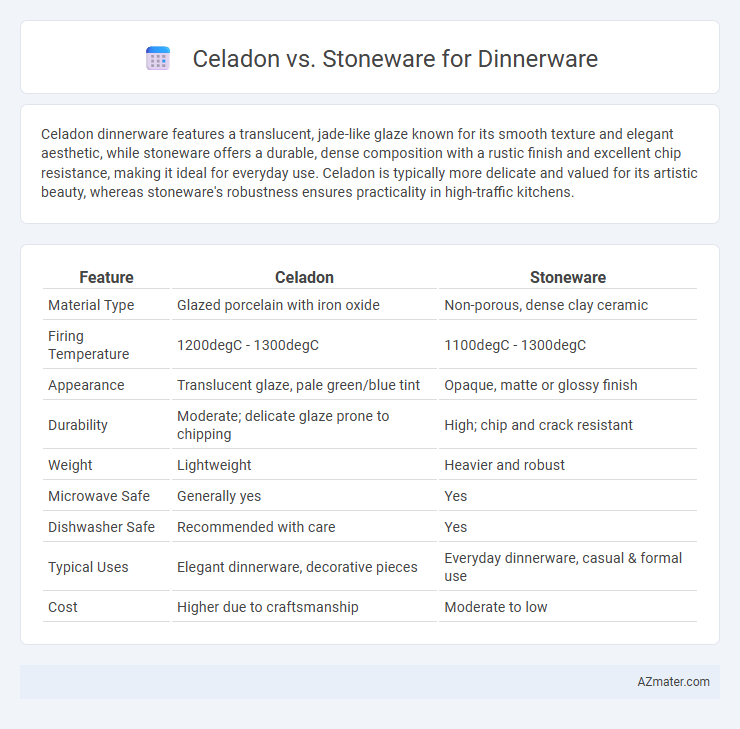Celadon dinnerware features a translucent, jade-like glaze known for its smooth texture and elegant aesthetic, while stoneware offers a durable, dense composition with a rustic finish and excellent chip resistance, making it ideal for everyday use. Celadon is typically more delicate and valued for its artistic beauty, whereas stoneware's robustness ensures practicality in high-traffic kitchens.
Table of Comparison
| Feature | Celadon | Stoneware |
|---|---|---|
| Material Type | Glazed porcelain with iron oxide | Non-porous, dense clay ceramic |
| Firing Temperature | 1200degC - 1300degC | 1100degC - 1300degC |
| Appearance | Translucent glaze, pale green/blue tint | Opaque, matte or glossy finish |
| Durability | Moderate; delicate glaze prone to chipping | High; chip and crack resistant |
| Weight | Lightweight | Heavier and robust |
| Microwave Safe | Generally yes | Yes |
| Dishwasher Safe | Recommended with care | Yes |
| Typical Uses | Elegant dinnerware, decorative pieces | Everyday dinnerware, casual & formal use |
| Cost | Higher due to craftsmanship | Moderate to low |
Introduction to Celadon and Stoneware Dinnerware
Celadon dinnerware features a distinctive jade-green glaze with origins in ancient China, prized for its smooth, translucent finish and subtle crackle patterns. Stoneware dinnerware is a durable, non-porous ceramic fired at high temperatures, known for its heft and rustic, earthy appearance that resists chipping and staining. Both types offer unique aesthetic and functional qualities, making them popular choices for versatile and long-lasting table settings.
Historical Origins and Cultural Significance
Celadon, originating from ancient China during the Tang Dynasty, is renowned for its jade-like glaze and delicate translucency, symbolizing purity and elegance in East Asian culture. Stoneware, with roots tracing back to prehistoric Europe and Asia, is valued for its durability and utilitarian design, embodying practicality across various cultures. Both materials have distinct historical trajectories and cultural roles, where celadon represents artistic refinement and stoneware reflects everyday functionality in dinnerware traditions.
Material Composition and Production Techniques
Celadon dinnerware is characterized by its unique glaze made from iron oxide that creates a translucent, jade-like finish, applied over a porcelain or stoneware base; the production involves a high-temperature oxidation firing. Stoneware dinnerware consists mainly of dense, non-porous clay fired at high temperatures in a reduction or oxidation atmosphere, resulting in a durable, opaque body. Celadon requires precise kiln control for its color development, whereas stoneware prioritizes robust forming and firing techniques for strength and chip resistance.
Aesthetic Differences: Color, Glaze, and Texture
Celadon dinnerware is renowned for its translucent, pale green glaze that creates a smooth, glass-like surface, emphasizing subtle color variations and delicate crackle patterns. Stoneware features a more robust, opaque finish with earthy tones ranging from warm browns to deep grays, highlighting a textured, often matte surface that contributes to its rustic appeal. The contrast between celadon's refined translucency and stoneware's hearty, tactile texture defines their distinct aesthetic identities in dinnerware collections.
Durability and Everyday Use
Celadon dinnerware, made from porcelain, offers a smooth, glazed finish that resists chips and scratches, making it suitable for everyday dining. Stoneware is denser and more robust, providing exceptional durability and resistance to heat, ideal for heavy daily use and microwave safe. Both materials maintain longevity, but stoneware generally withstands rough handling better than celadon.
Microwave, Oven, and Dishwasher Compatibility
Celadon dinnerware typically features a delicate glaze that is microwave-safe but may crack under high oven temperatures, making it suitable for reheating but not baking. Stoneware is highly durable, offering excellent resistance to oven heat up to 500degF and is generally safe for microwave use without risk of thermal shock. Both materials are dishwasher-safe, though stoneware withstands repeated dishwasher cycles better due to its robust composition.
Price Range and Affordability
Celadon dinnerware typically commands a higher price range due to its intricate glaze and artisanal craftsmanship, often starting around $50 per piece and reaching several hundred dollars for premium sets. Stoneware offers a more affordable option, with sets commonly priced between $20 to $100, balancing durability and budget-friendly appeal. Choosing between celadon and stoneware depends on whether you prioritize luxury and aesthetic sophistication or cost-effective, everyday use.
Sustainability and Environmental Impact
Celadon dinnerware, crafted from high-fired porcelain with natural vegetable ash glazes, generally uses fewer synthetic chemicals and offers greater biodegradability compared to heavier, vitrified stoneware, which requires more energy-intensive firing processes. Stoneware production often involves higher resource consumption due to thicker clay bodies and extended kiln times, contributing to increased carbon footprints and energy use. Choosing celadon supports sustainability through lower energy inputs, reduced waste, and more eco-friendly glaze materials, aligning with environmentally conscious dinnerware preferences.
Popular Brands and Market Availability
Celadon dinnerware, known for its translucent glaze and subtle greenish hues, is prominently offered by brands like Noritake and Lenox, which cater to a market favoring elegant, artisanal tableware. Stoneware, characterized by its durability and rustic aesthetic, is widely available from popular brands such as Corelle and Le Creuset, appealing to consumers seeking functional yet stylish everyday dinnerware. Both types are readily accessible through major retailers like Amazon and Williams Sonoma, ensuring a broad market presence and diverse selection for buyers.
Choosing the Best Dinnerware for Your Table
Celadon dinnerware offers a translucent glaze with subtle green tones that enhance elegant table settings, while stoneware is known for its durability and rustic, earthy appearance. When choosing the best dinnerware for your table, consider celadon's refined aesthetic and suitability for formal occasions versus stoneware's robustness for everyday use. Prioritize factors like dishwasher and microwave safety, chip resistance, and the visual harmony with your dining decor to ensure both functionality and style.

Infographic: Celadon vs Stoneware for Dinnerware
 azmater.com
azmater.com